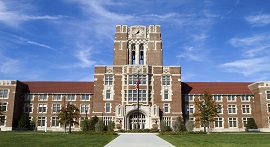Osteopathic Medicine
Overview
Doctors of Osteopathic Medicine (D.O.s) are fully trained physicians, licensed to prescribe medications and perform surgeries in all fifty states. Osteopathic physicians work side by side with Doctors of Medicine (M.D.s), usually filling primary care positions in hospitals or clinics. Today, they comprise ten percent of all practicing doctors in the United States.
Osteopathic medical training is similar to allopathic medical school in several ways. Like allopathic training, the first two years of schooling are built around foundational coursework in the medical sciences, followed by two years of clinical rotations in an affiliated teaching hospital. However, osteopathic medicine diverges from allopathic medicine in several distinct ways.
First, osteopathic medicine focuses strongly on the musculoskeletal system and its relation to overall health. In addition to traditional clinical skills, osteopathic physicians receive additional training in osteopathic manipulative treatment, or OMT, (not to be confused with chiropractic manipulation), a technique designed to correct disorders related to the bones, muscles, or nerves. OMT however, is just one of the hallmarks of osteopathic medicine. In addition, the philosophy behind osteopathic medicine is decidedly holistic. Core coursework is taught with a focus on how each discipline relates to a person's overall health and wellness.
Osteopathic medicine programs train students in both medical and humanitarian qualities, and aim to incorporate more preventative medicine than is traditionally taught in allopathic schools. For example, when diagnosing a patient, osteopathic physicians are trained to examine their social and economic situation, mental health, and eating habits and nutrition, in addition to conducting physical examination or lab work.
After completing their degree, osteopathic physicians must pass their state and national licensing exams for osteopathic physicians. After passing the boards, they participate in the same residency-matching program as allopathic doctors. Osteopathic physicians practice in every medical subspecialty. If you are interested in primary care—especially with a holistic approach—osteopathic medical school is an excellent option. If you want to work in medical research or a competitive specialty area, consider a dual degree like a D.O./Ph.D, M.D./Ph.D., D.O./M.P.H., or M.D./M.P.H..
Degree Information
The Doctor of Osteopathic Medicine is the only degree offered by osteopathic medical schools. Some programs may offer joint degrees with an affiliated business school (D.O./M.B.A), school of public health (D.O./M.P.H.), or other graduate program (D.O./M.A. or D.O./Ph.D.)
Questions to Ask Yourself When Choosing a Degree Program
- What courses comprise the curriculum? Is the curriculum organ/system-based, or is it discipline-based?
- What elective coursework is offered? What are the school's strengths and weaknesses?
- What are the clinical facilities like? Where are they located?
- What is the patient base in the area? Is the setting rural or urban?
- How is the clinical training divided? What rotations comprise the most time and which comprise the least?
- What clinical electives are available?
- What types of residency matches do most graduates get?
- What medical fields are graduates working in?
Career Overview
Doctors of Osteopathic Medicine are fully licensed physicians, practicing with all the same rights and privileges as M.D.s. Based on their residency and training, D.O.s can practice in any medical subspecialty, from surgery to community medicine. Sixty-five percent of D.O.s practice in primary care fields, generally defined as Ob/Gyn, Pediatrics, Internal Medicine, Emergency Medicine, and Family Practice. D.O.s treat patients in the same manner as most M.D.s; however, in addition to traditional medical techniques, osteopathic physicians may also use manual manipulation of the body to ease pain and enhance the body's healing power.
Most osteopathic physicians practice medicine in hospitals or other clinical settings. Many also work in private, family practice, sometimes in rural areas in the United States that are underserved by medical care.
Career/Licensing Requirements
To practice as a D.O., you must complete an accredited program in osteopathic medicine, complete an internship/residency of at least 12 months, and successfully pass the national licensing exam.
Salary Information
Most D.O.s earn between approximately $70,000 and 80,000 per year to start.
Related Links
American Osteopathic Association
The American Osteopathic Association, a professional association of Doctors of Osteopathic Medicine includes articles and publications, news, job opportunities, and an array of benefits for its members.
American Osteopathic Foundation
The American Osteopathic Foundation is a nonprofit foundation benefiting osteopathic medicine and education.
American Association of Colleges of Osteopathic Medicine
The American Association of Colleges of Osteopathic Medicine is an organization of all thirty-one osteopathic medical schools. Includes the centralized application service (AACOMAS) for students seeking admission to osteopathic schools.
RELATED GRADUATE PROGRAMS
SAMPLE CURRICULUM
Anatomy
Biochemistry
Emergency Medicine
Histology
Immunology
Infectious Disease
Internal Medicine
Microbiology
Neuroscience
Nutrition
Ophthalmology
Pathology
Pediatrics
Pharmacology
Physiology
Psychiatry
Radiology
Featured MBA Programs For You
Connect with business schools around the globe and explore your MBA options.

Best Business Schools
Check out our lists of best on-campus and online MBA programs and find the best program for your career goals.
Explore Graduate Programs For You
Ranked master’s programs around the globe are seeking students like you to join their programs.
Med School Advice
Get medical school application advice, USMLE prep help, learn what to expect in med school and more.


